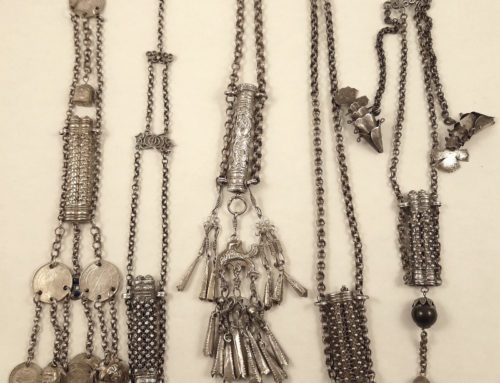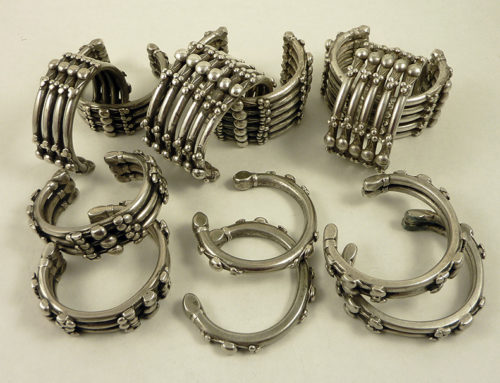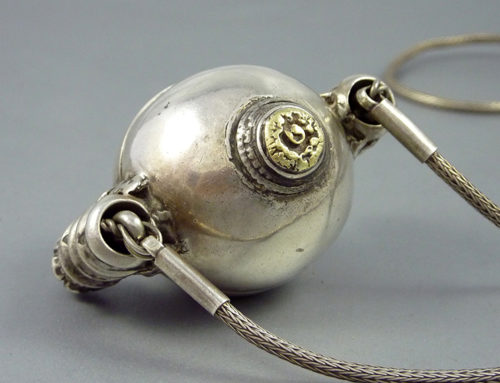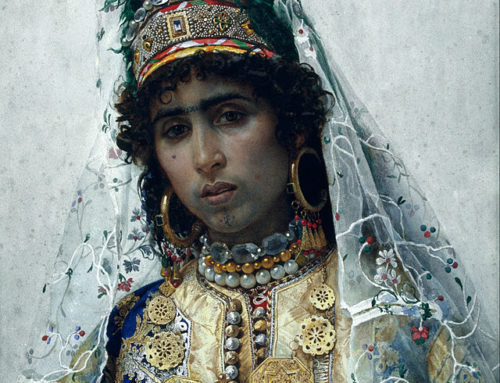Buying genuine Ethnic jewelry
Over the past years, I have often been asked about how one can tell the authenticity of old ethnographic silver jewelry.
In the last couple of decades, old ethnic jewelry has become highly collectible. The progressive disappearance of ethnic traditions in the Middle East and Asia means that fewer and fewer ethnic jewelry items arrive to the markets. Some pieces are scarce and in consequence, prices rise.
This is when it becomes tricky: when there is money to make, there are soon fakes available to buy.
We have seen the same process happening in other areas like Modern Art, gemstones, etc.
How to distinguish old ethnic jewellery?
Here are some clues:
- Too good to be true: It is not impossible to find good deals on the market, but in case you find a very good deal there can only be two possibilities: the dealer doesn’t know what he/she is selling (or he/she doesn’t care) or it is a fake!
- Don’t fall into the belief that because you buy an item in the country of origin (or it has come directly from the country of origin) the piece will be cheaper. Dealers in any country of the world know what they are dealing with, and they will hardly sell an original unique antique for a cheap price (as I said before, good deals can always be reached, but not as a norm). This is especially true now, that the Internet and social media are easily available from the phone, and dealers can check the actual prices of some of the pieces they have.
- Labels like old, antique, can be very misleading when applied to Ethnic jewellery. Be aware that any piece older than the beginning of the 20th century is rare, unless it was brought from the country of origin decades ago. Older pieces are already in Museums and private collections. In many countries, ethnic jewelry is not passed down from mothers to daughters, but it is melted in order to do new shinny silver jewelry. That means that ethnic jewellery is usually not very old. Even if there are heavy signs of wear it doesn’t mean that the bracelet or the ring is very old! Take for example Indian or Tibetan jewelry, that is worn nonstop for years while cooking, taking care of the family and working in the fields: silver can get a very nice patina very easily! Another aspect to understand is that, for example in India, old doesn’t have the same meaning than with us, so you may be talking about something old and thinking it is 100 years old, but the seller maybe is thinking in 15-20 years old. The dealer is not trying to mislead you, but he/she truly think the piece is old!
- Be suspicious when finding many similar items all of a sudden online (eBay, auction houses) and on markets. Ethnic jewellery is still produced nowadays in some countries like India, but in some other places and due to economic or political changes, old traditions are not followed anymore. That means that if a type of jewelry that was abundant in the 80s’, has disappeared from the market for decades, it is unlikely that suddenly there are many similar pieces available. They are probably new.
- Check carefully the wear of the piece. Wear can be faked with tools, and bumps and dents can also be produced easily, but in which places would a ring have more wear, everywhere or between the fingers? Would the interior be soft? Surface areas are smooth, especially where they contact skin. There are usually no sharp edges. Contour edges of the piece, bezels, and seams are worn, not “fresh” or sharp. Hammered or raised designs will be worn smooth, from frequent touching.

- Pay attention to descriptions like “Bedouin silver”, “ethnic silver”, “coin silver”, “Tibetan silver”, usually euphemisms to tell you that there is no silver at all but just a mix of metals. Ask the seller to be clear about silver content, if any. If handling the piece, you will feel silver nicely heavy and compact, compared to other silver alloy or metal alloy pieces. That said, it could also be that a piece made of metal like aluminum is perfectly genuine and traditionally used, but prices can never be the same as pieces made of high-grade silver. A good knowledge of the region and materials traditionally used can help you to identify a genuine piece from a fake.
- Good silver is made from silver and copper, sterling being 92.5% elemental silver. It will oxidize naturally when sitting for a long time in your drawers, but will polish beautifully with silver polish, a silver cloth, or when rubbed briskly on cotton cloth. Color is a reliable indicator but takes training. Good silver is not greenish, yellow or copperish and not too white. The old ethnographic silver was not stamped 925 (unless it has been hallmarked when crossing customs in some countries), so you have to train yourself. An eye for these attributes will come over time.
- Check also the oxidation of the silver There will be a blackish antique patina which is a result of years of built-up human soil and dirt; silver made to look old is dipped in a chemical bath and will not rub off except under a powerful polishing wheel. A chemical dip “age patina” is often a bluish, or gray/green color and is practically a sure thing on new, mass market ethnic jewelry.
But the best advice I can give is to study the traditional work of silver and goldsmiths, learn how the jewelry is constructed, the techniques, gemstones used, motifs… In this way, you will spot incongruences, like a non-native flower or animal depicted or an incongruent religious symbol.
This is not something you can learn quickly, it takes years to learn, after reading books, going to Museums, and making a lot of mistakes, but in the end, it is possible to see or at least to get a feel of suspicious pieces. If in doubt, trust knowledgeable dealers who have studied and touched ethnic jewelry for decades. I use academic and museum references when determining the cultural and material anthropology of ethnographic jewelry. Books are expensive, but you can still search on the database of Museums and collections, or seek advice on social media groups.
Old pictures of people wearing ethnic jewellery are also a very good way to learn about genuine ethnographic jewellery and how it is worn (Pinterest is a good place to start).
It is not bad to buy or appreciate newly made ethnic jewelry. What is crucial is that you know the differences that exist, so you know exactly what you are buying and how much to pay for it. Today throughout India, Turkey, Nepal, Africa, and other countries, small communities are developing artisan coops to maintain traditional indigenous artistic techniques and designs. This is a powerful effort to preserve cultural traditions and relevance and participate in a market economy. I wholly support buying these goods which maintain a high standard of quality.
Remember that if you love something and it is valuable to you for its beauty or its origin, or because you bought it at that magical open air market in Morocco, Turkey, or Delhi; or the day you fell in love at the flea market; then there is no objective criteria to determine fair market value. But do it with full knowledge of what you are buying!
Leonor Arnó Pons
Expert and appraiser of Ethnic jewellery and ornaments









